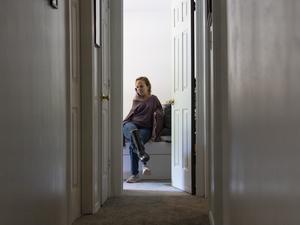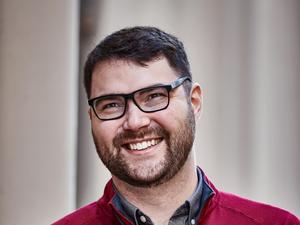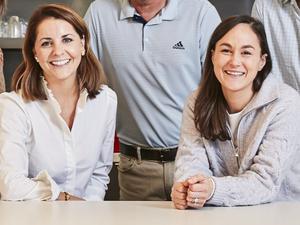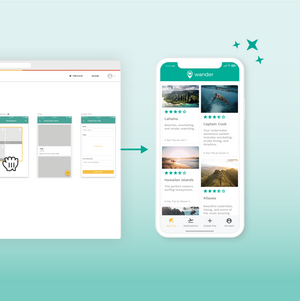Letisha Wexstten stood behind the video camera. In her sights was David Carnahan, sitting at a computer, typing.
It was a mundane activity that, considering the stories of both Wexstten and Carnahan, was anything but mundane.
Wexstten, 36, was born without arms and a condition that made one leg shorter than the other. Carnahan, 42, survived a self-inflicted gunshot 10 years ago that left him blind, with facial deformities and speech impairment.
Their conditions make them different from the rest of the workforce, enough that employers might question, without exploration, things like whether a blind man can navigate his way across a keyboard. So in filming this moment, Wexstten was attemping to do for Carnahan what she'd already succeeded in doing for herself: Build a career.
Ten years ago, Wexstten struggled to secure work as a graphic designer and began publishing videos of herself completing daily tasks. The videos brought national attention and job offers, eventually turning her into an entrepreneur as founder and CEO of V15able (pronounced "visible"), a St. Louis startup that launched in 2019 with a mission to create an online platform connecting employers to disabled job candidates, like Carnahan.
V15able helps disabled workers create online profiles that showcase their abilities while connecting them with employers. It's starting to attract employers onto its platform at a time when companies are showing signs of recognizing the potential of tapping into the disabled workforce.
A tight labor market, with historic levels of open jobs, has forced employers to give greater focus on recruiting and retaining individuals with disabilities, a group that experts say has long been a “hidden” talent pool. In 2021, only 19.1% of people with disabilities were employed, according to the U.S. Bureau of Labor Statistics. That compares to 63.7% of able-bodied workers.
Some of St. Louis' largest employers are also addressing the issue. Maryland Heights-based technology consultancy World Wide Technology and St. Louis-based financial services giant Edward Jones — Nos. 2 and 3, respectively, among the region's largest privately held companies — in the past year made moves to offer more resources for disabled workers while also hiring for new roles specifically focused on accessibility.
Signs of momentum are starting to emerge. The percentage of people with disabilities who were employed last year climbed from 17.9% to 19.1%. That progress, though, wasn't enough to close a sizable gap: The unemployment rate for disabled workers last year was 10.1% compared to just 5.1% for those without disabilities.
“Regardless of where the economy is, it is twice as bad for disabled people,” said Jason Hartsfield, career adviser and lead disability inclusion consultant at the Starkloff Disability Institute, a St. Louis-based support organization for the disabled workforce.
Wexstten's objective is to move the needle even further.
On a visit last month to Carnahan’s Chesterfield apartment, she recorded him talking about his job capabilities and career goals, which include finding a role where he can make a difference within a company. She documented how, despite his blindness, Carnahan still can use his phone and computer to send emails, make calls and complete other tasks. The goal of video is to ensure employers don't pass him over because of his disabilities.
After his shooting incident, Carnahan spent eight years in a nursing home, regaining his independence in early 2021. He's eager to return to a workforce that has thus far proved disheartening.
It's stories like his that motivate Wexstten.
“In one instance, the interviewer saw him and said ‘oh no’ and then turned off her computer and shut down the Zoom call and never called him back,” Wexstten said.
Lights, camera, action
Wexstten’s frustration boiled over.
As she applied for jobs as a graphic designer in 2012, her applications kept getting passed over as she received the standard rejection letters from employers. She had a portfolio of work to show, assistance from employment agencies and an associate’s degree from St. Louis Community College.
None of it seemed to matter.
“I couldn’t find a job and I felt like it was my disability — that they didn’t understand,” Wexstten said. “They took one look at me and said ‘well you don’t have arms, you can’t do this.’”
Wexstten had spent her life learning to adapt to living without arms.
She taught herself how to use her feet like they were hands. When she was young, she would sit on her family's kitchen floor and practice picking up beans with her feet, placing them into a jar.
She has also spent her life proving to others that their first impressions were wrong.
During elementary school, administrators initially wanted to enroll her in the special school district, she said. It was on her to convince them to let her learn in a regular classroom.
“I had to show them that I was capable of coloring in a coloring book or cutting with scissors," she said. "That’s something they needed to know I was capable of doing."
During that 2012 job search, Wexstten realized once again that she’d have to show those in charge her capabilities. On a rainy day, she pulled out a camcorder and began filming herself making a peanut butter and jelly sandwich.
You can see her there in the kitchen, jumping onto the counter, using her shoulder to open a cabinet and grabbing a plate with her foot before washing her feet.
“Sanitation is key when using your feet because there are a lot of germs on the floor,” Wexstten said.
She didn't expect much from the video. Shortly after uploading it to YouTube, she saw that five people had watched it.
"Oh, that's really cool," she thought.
An hour later, the number of views grew to 500.
"I'm thinking, do I even know 500 people?" she said.
She produced more videos showing how she completes other daily tasks, like driving a car, putting on makeup and grocery shopping.
Today, that initial video of Wexstten making a sandwich has more than 4.4 million views and yielded several job offers. Her YouTube channel, "Tisha Unarmed," has 162,000 subscribers.
“I never thought that they were going to have the reach that they did,” she said.
Wexstten considers the YouTube page to be her first endeavor in entrepreneurship. While those videos weren't envisioned as a business opportunity, the feedback from viewers, especially others with a disabilities, opened her eyes to the realization that she was filling a need.
“At some point in time I realized I'm just one person. I cannot be the only person who does this,” she said. “I had the tip of it. How can I create a community? It wasn't until two or three years later that V15able was born from that thought."
'We've got to be a part of this business'
At a startup showcase in November 2019 at The Globe Building downtown, the founders of local startup studio Sigla worked the room, introducing themselves to the dozens of entrepreneurs who were there presenting their companies. Sigla is a startup consultant, helping entrepreneurs launch and scale their ideas, and its leaders were on the hunt for a company that might fit its business model.
One entrepreneur caught their eye: Wexstten.
“Out of all those, we’re like, 'this is the one that we have to work with,'” said Sigla Chief Technology Officer James Dickman. “We never say that actually, but we just came away with the impression with her, saying ‘we’ve got to be a part of this business.’"
The idea for Wexstten's business developed out of her aspiration to create a mechanism that could give disabled workers the ability to seek out jobs on equal footing with their able-body peers. It has developed an online jobs platform specifically designed for workers with disabilities. Job candidates can create profiles that detail their disabilities, qualifications and the accommodations they need for accessibility to do their jobs. For example, a candidate has the ability to include videos of them showcasing their abilities, while employers recruiting through the platform can outline the steps they take to make disabled workers feel welcomed and accommodated at their businesses.
At the startup event in 2019, Wexstten was in the early stage of turning her idea, formed in a senior thesis class at the University of Missouri-St. Louis, into a full-fledged company. She used a $15,000 grant won through an UMSL student pitch contest to create a business plan, and had just added $50,000 from St. Louis startup funder Arch Grants to grow the company.
Dickman and his co-founders, Chief Design Officer Charlie Eaton and Chief Operating Officer Jason Wargel, had helped launch other St. Louis startups, including advertising technology firm Advocado and senior-focused Odd Fellows Housing. They wanted to do the same for Wexstten’s V15able, believing they could help her refine her business strategy and develop technology to launch a jobs platform.
But Wexstten was hesitant.
Having just won $50,000 from Arch Grants, she had concerns people would take advantage of offering help, knowing she was a new entrepreneur and just received an influx of cash. The team at Sigla was determined to work with V15able, meeting with Wexstten for several weeks, developing trust between the two before a deal was made.
The Sigla co-founders were inspired by Wexstten and her ability to turn her experience into a mission-driven enterprise with an innovative product.
“There’s a huge market upside with this business,” Dickman said.
Historically, workers have been coached to say as little as possible about their disability through the hiring process, Wexstten said. With V15able, she’s built a hiring platform that gives disabled workers the confidence to be their authentic selves as they search for work.
“We’re putting candidates in a better place to present employers with a package of accessibility and say ‘hire me,’ not because I have a disability, but because I am the best candidate and I do have challenges, but we can solve them together,” Wexstten said.
V15able is designed to generate revenue through subscription fees paid by companies that allows them to create recruiting profiles and gives them access to connect and interact with candidates on the jobs platform.
Wexstten, along with the Sigla team, has spent the past three years incubating her startup, developing the technology that will power its job platform. So far, it has signed on more than 50 job candidates and is in the process of finding recruiters to test the platform for a few months before launching it publicly. Wexstten said most of the job candidates are local, but that V15able has had discussions with employers who have a nationwide footprint.
“My goal is for it to be massive,” she said. “I’d like for every person with a disability who is looking for a job to be able to through V15able.”
Wexstten has built V15able on a shoestring budget. The Sigla team, along with Chief Revenue Officer Abbey Sweeny, are serving in executive roles for the startup. However, they are unpaid and are operating in their roles for equity in the startup. Expenses for the startup have included paying for the cost of development of its jobs platform.The business will need more funding to expand its technology and capabilities, Wexstten said. Earlier this year, it received $31,000 from an undisclosed angel investor. Wexstten is hopeful that launching the jobs platform and showing its impact will lure more capital to grow the company. V15able is seeking $315,000 in investment, funding Wexstten says will be used to hire staff, add new features to its jobs platform and to target sales and marketing opportunities.
“We really just need an angel investor or something of the sort to help us move forward with the development of it," she said. "I think that will come once we get a number of candidates on the platform and a number of recruiters on the platform, showing the value of a company using the website.”
Adding the ‘A’ to DEI
Speaking last month to an audience of more than 350 people inside an auditorium at Edward Jones' St. Louis headquarters, Wexstten shared some figures that startled her as she founded her company in 2019.
At the time, there were more than 7 million jobs open each month in the U.S., but only 6 million able-bodied workers that could fill them.
“I’m not a mathematician or anything, but seven minus six, there are still one million job openings each year that can't be filled by able-bodied people,” Wexstten told the audience. “And we are not looking in the right spot.”
The number of open roles has only increased in the years since Wexstten launched V15able, with 10.7 million open roles and 5.7 million job seekers in October, according to the latest data from the federal Bureau of Labor Statistics. Perhaps now, more than ever, employers are struggling to fill open roles, and the disabled represent a cohort of possible employees that is too often hiding in plain sight.
A November 2021 report from the Federal Reserve Bank of St. Louis called disabled workers an “untapped” talent pool, noting there’s 24.8 million people with disabilities who are unemployed or out of work. But despite that massive pool of workers, the Fed’s report said those job hunting “face a variety of structural and attitudinal barriers to gainful employment.” Even as employers have made diversity, equity and inclusion initiatives central to their operations in recent years, some disability advocates say the acronym of DEI is missing a letter: A for accessibility.
“It’s not generally thought of as a DEI issue until someone with a disability brings it up in the organization,” said Hartsfield, the disability inclusion consultant with the Starkloff Disability Institute.
But Hartsfield believes the door is beginning to open more for disabled workers. One accelerant has been the rise in remote work, a ripple effect of the Covid-19 pandemic. It has reduced barriers such as transportation and workplace accommodations for those with disabilities, said Aimee Wehmeier, president of Paraquad, a local nonprofit that helps disabled individuals gain independence.
“There’s greater flexibility. The hybrid work environment, modified schedules and some of the things that were always out of the question in the past are now bargaining tools for all people, with or without disabilities,” she said.
Companies are also starting to take more steps to incorporate disability into their inclusion efforts, said Hartsfield. He’s seeing more companies hiring for disability-specific roles, launching more affinity groups for disabled employees and increasing communication about their commitment to accessibility.
Wexstten’s speech last month at Edward Jones serves as an example.
Her appearance was part of an event hosted by the firm’s disabilities-focused adaptABILITIES business resource group, which launched in 2018. It’s one of several initiatives undertaken by Edward Jones in recent years to put more of a focus on disabilities. Last year, the firm added "disabled" to its employee self-identification program, part of an ongoing expansion of categories included in that program. Edward Jones uses the program, which also includes disclosures around gender, race and sexual orientation, to assess equity and inclusion internally.
“It really helps us as a firm use data to ensure that all of our colleagues are having the same wonderful experience at Edward Jones. When we do things like engagement surveys and we look at experiences across the firm, we’re able to use that data not only an individual basis, but as a group to say ‘are our disabled associates having the same experience as individuals who have not identified with a disability?',” said Jennifer Kingston, head of diversity, equity and inclusion at Edward Jones.
More recently, Edward Jones has hired a director of disability inclusion and accessibility, Monica Reha, who will be in charge of implementing a disability strategy for Edward Jones’ employees and clients.
World Wide Technology also has recently hired an accommodations specialist, a newly created position.
Like Edward Jones, WWT, which provides technology products and services globally for large businesses and government entities, is sharpening its focus around disability inclusion. In 2021, the privately held, $14.5 billion firm formed a new employee resource group, called WWT Able, and in July announced it inked a partnership with Inclusively, a St. Louis company that has developed a workforce inclusion platform to help companies find disabled workers.
“When you have an inclusive environment, regardless of race, gender, physical disability, you have to be able to understand that all of those things are going to produce more creative and innovative outcomes for projects and whatever you do as an organization,” said Ann Marr, WWT’s executive vice president of global human resources.
The end goal
Carnahan's job search continues.
He's not jobless. He works with the Starkloff Disability Institute, helping the nonprofit's career academy by sharing his own job experience with other disabled individuals also looking for work. But before his incident, Carnahan was a firefighter, and what he really wants is to return to a service-related job where he can be present in the community.
"I still have that mindset," he said. "I want to help people."
Carnahan said he's uncertain about the specific type of role he wants, but envisions a back-office support position as one that might be ideal.
Last week, Carnahan and Wexstten met again in Maryland Heights at the Center for Head Injury Services, which has helped in his job search. Together, they spent time looking at a job websites, discussing the type of jobs that will be most attractive to Carnahan. Wexstten again brought her camera to collect more video for his V15able profile.
Carnahan is optimistic a job offer will hopefully come soon. For him, landing a job isn't about paying his bills.
"It's not necessarily about the income or the money. It's purpose," he said. "I don't want just to live as a leech. I want to make a contribution."
Wexstten understands that drive.
As a student at UMSL, when it was suggested she submit her startup idea for a student pitch contest, she nearly passed on the opportunity. She wasn’t sure she was cut out to be an entrepreneur. The other presenters had spreadsheets full of numbers and predictions for their companies for 10 years in the future. Wexstten’s pitch was different.
“Mine was really simple. And I just said, ‘here's a problem. I want to solve it and here’s how I can.'”
Four years later, Wexstten is focused on growing a profitable business, though her mission includes a unique aspect for an entrepreneur. She wants to put herself out of business.
“Once we get a certain amount of people on the platform and a lot of people with disabilities jobs, I think the industry is going to change to where V15able is not going to be necessarily needed anymore because it’s going to be so common to hire people with disabilities,” she said. “That’s our goal.”












